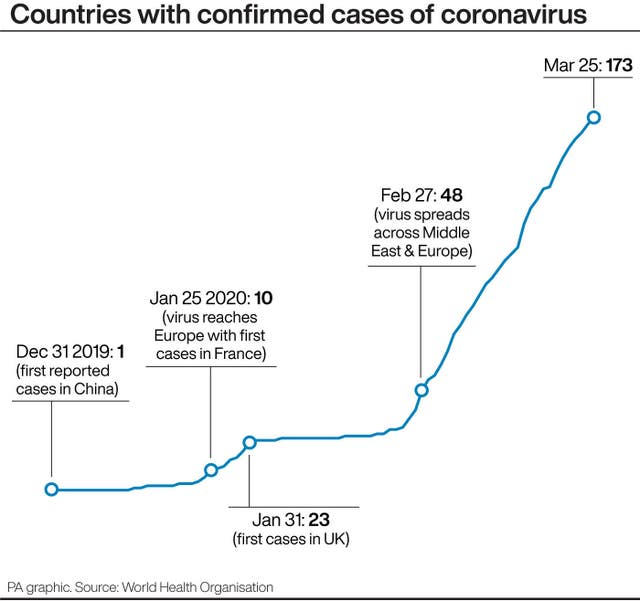1.3 billion people locked down in India in bid to halt coronavirus
The move came as US congress and the White House reached an agreement on a massive American aid programme.

India’s population of 1.3 billion people has been ordered to stay at home under the world’s biggest lockdown in a bid to stop the coronavirus pandemic.
The unprecedented move was aimed at keeping the virus from spreading and overwhelming India’s fragile healthcare system as it has done in parts of Europe, where infections are still surging.
New York, meanwhile, has scrambled to set up thousands of new hospital beds, while organisers delayed this summer’s Tokyo Olympics until next year.
The deal would give direct payments to most Americans, expand unemployment benefits and provide a 367 billion dollar (£313 billion) programme for small businesses to keep making payroll.
In India, everything but essential services like supermarkets were closed. Normally bustling railway stations in New Delhi were deserted and streets that just hours before had been thronged with cars were eerily silent, with just a trickle of pedestrians.

In Washington, top White House aide Eric Ueland announced the two trillion-dollar US domestic aid package to help those affected by the outbreak.
The deal came after days of haggling and still needs to be finalised in detailed legislative language.
With Americans’ lives and livelihoods hanging in the balance, President Donald Trump said he hoped to reopen the country in less than three weeks.

With infections in the US exceeding 55,000, including more than 690 deaths, public health experts have warned that failing to maintain social distancing would balloon infections to the point the healthcare system would be overwhelmed and many more people would die.
More than 423,000 people worldwide have been infected by the virus and nearly 19,000 have died, according to a running tally by Johns Hopkins University.
A recent flicker of hope for Italy, which has seen the most deaths in the world, faded with an increase in both new cases and fatalities on Tuesday.

There are signs, however, that drastic measures to keep people away from one another can push back the spread of the illness.
In China, the province of Hubei where the outbreak was first spotted late last year started lifting its lockdown.
Some train stations and bus services reopened in Hubei on Wednesday and people who passed a health check will finally be allowed to travel for the first time since January.
A similar easing in the hard-hit epicentre of Wuhan is planned for April 8, though buses and subways could start sooner.

It is the latter cases – often requiring ventilators and specialised care – that threaten to overwhelm hospitals, which in several countries are already running short of critical equipment needed to treat patients and keep doctors and nurses safe.
In New York, the number of cases is doubling every three days, threatening to swamp the city’s intensive care units in the weeks ahead, governor Andrew Cuomo said. The state has recorded more than 200 deaths, or one third of the US total.
Mr Cuomo said: “One of the forecasters said to me: ‘We were looking at a freight train coming across the country.’
“We’re now looking at a bullet train.”
Mr Trump has invoked the Korean War-era Defence Production Act to deter hoarding, but has been reluctant to use it to force companies to produce medical supplies.
US vice president Mike Pence said on Fox News that 2,000 ventilators have been shipped to New York and 2,000 more will be sent on Wednesday.
Spain, meanwhile, registered a record one-day increase of nearly 6,600 new infections and a leap of more than 500 deaths, reaching almost 2,700.
The country started storing bodies in an ice rink converted to a morgue until they could be buried or cremated.

In Italy, a jump in the number of new deaths and cases dashed hopes fed by two days of declines. The 743 deaths reported on Tuesday pushed Italy’s toll past 6,800.
Health minister Roberto Speranza said: “Woe to whoever lets down their guard.”
World Health Organisation spokeswoman Margaret Harris said cases around the world are expected to increase “considerably”.
With no end to the crisis in sight, the International Olympic Committee postponed the 2020 Tokyo Olympics until the summer of 2021 at the latest, acting on the recommendation of Japan’s prime minister Shinzo Abe.

Prime Minister Jacinda Ardern said: “I have one simple message for New Zealanders today as we head into the next four weeks: Stay at home.
“It will break the chain of transmission and it will save lives.”
In Brazil, which has seen about 2,200 cases, President Jair Bolsonaro took a different approach, sticking with his contention that virus concerns were overblown.
He said: “The virus arrived, we are confronting it, and it will pass shortly.
“Our lives have to continue, jobs should be maintained.”
Mr Bolsonaro said certain Brazilian states should abandon their “scorched earth” policy of prohibiting public transport, closing business and schools, and urging people to stay home.





